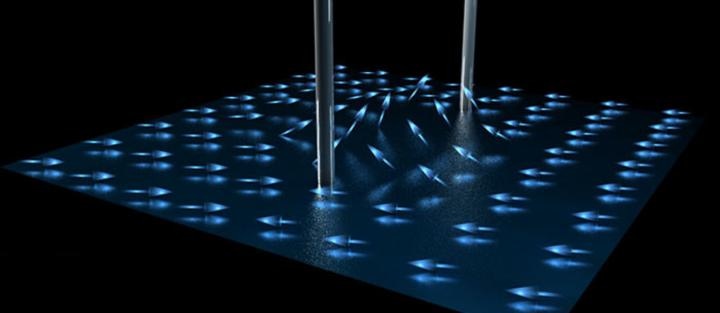Jan 17 2019
Scientists, for the first time, have recorded the long-predicted existence of “walls bound by strings” in superfluid helium-3. Originally predicted by cosmology theorists, the occurrence of such an object may be helpful in describing the way in which the universe cooled down following the Big Bang.
 Representation of the spin vectors of the liquid helium as they form half-quantum vortices. (Image credit: Ella Maru Studios)
Representation of the spin vectors of the liquid helium as they form half-quantum vortices. (Image credit: Ella Maru Studios)
The newly discovered potential to recreate these structures in the laboratory finally offers earth-based researchers a means to more closely analyze certain possible scenarios that might have occurred in the early universe.
The outcomes of the study, reported in Nature Communications on January 16th, 2019, were achieved following two consecutive symmetry-breaking phase transitions at Aalto University’s Low Temperature Laboratory.
At atmospheric pressure, helium remains a liquid even if it is chilled down to absolute zero. At such temperatures, all other materials freeze to become a solid. Besides remaining fluid at cryogenic temperatures, helium transforms into a superfluid at an adequately low temperature. The viscosity of a superfluid material is typically zero, indicating that it should flow without any energy loss forever.
Researchers can confine the isotope helium-3 to a nano-structured volume to use its superfluid phases to analyze effects such as half-quantum vortices, or whirlpools produced in the superfluid in which the amount of helium that flows is strictly regulated by the rules of quantum physics.
We initially thought that the half-quantum vortices would disappear when we lowered the temperature. It turns out that they [half-quantum vortices] actually survive as the helium-3 sample is cooled below half a millikelvin—instead a nontopological wall appears.
Jere Mäkinen, Study Lead Author, Doctoral Student, Aalto University
Although the nontopological walls are not physical walls that would block the flow, they modify helium’s magnetic properties. The scientists could identify the variations with the help of nuclear magnetic resonance.
Some cosmologists consider that following the Big Bang, in the first few microseconds, the entire universe underwent symmetry-breaking phase transitions, such as a superfluid inside a nano-structured volume as it is cooled down. Theoretically, in the ultra-condensed universe, topological defects or quantum fluctuations, such as quantum vortices and domain walls, were frozen in place during the expansion of the universe. As time passed, the frozen fluctuations turned into the galaxies observed at present, and in which humans live in, today. The ability to create these objects in the laboratory may help gain more insights about the universe and the reasons it formed in the way it did.
The additional benefit is that the structure of these hurricane-like flaws created by Mäkinen in the lab also offers a prospective model for the analysis of topological quantum computing.
While liquid helium-3 would be too hard and expensive to maintain as a material for a working computer, it give us a working model to study phenomena that could be used in more accessible future materials.
Jere Mäkinen, Study Lead Author, Doctoral Student, Aalto University
Half-quantum vortices were first predicted by Professor Emeritus Grigori Volovik, co-author of the new research, together with V. P. Mineev in the 1970s. The vortices were first noted in helium superfluid in 2016, in the Aalto Low Temperature Lab.